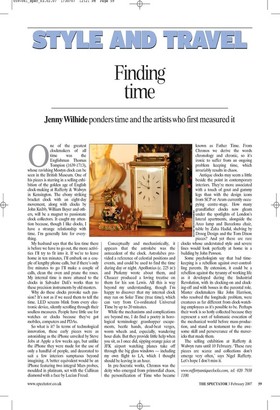Finding time
Jenny Wilhide ponders time and the artists who first measured it ne of the greatest clockmakers of all time was the Englishman Thomas Tompion (1639-1713), whose ravishing Mostyn clock can be seen in the British Museum. One of his pieces is starring in a selling exhibition of the golden age of English clock-making at Rafferty & Walwyn in Kensington. The ebony striking bracket clock with an eight-day iJ movement, along with clocks by John Knibb, William Beyer and others, will be a magnet to passionate clock collectors. It caught my attention because, though I like clocks, I have a strange relationship with time. I'm generally late for everything.
My husband says that the less time there is before we have to go out, the more activities I'll try to fit into it. If we're to leave home in ten minutes, I'll embark on a couple of lengthy phone calls, but if there's only five minutes to go I'll make a couple of calls, clean the oven and prune the roses. My internal time is more attuned to the clocks in Salvador Dali's works than to these precision instruments by old masters.
Why do these clocks provoke such passion? It's not as if we need them to tell the time. LED screens blink from every electronic device, silently scrolling through their soulless measures. People have little use for watches or clocks because they've got mobiles, computers and PDAs.
So what is it? In terms of technological innovation, these early pieces were as astonishing as the iPhone unveiled by Steve Jobs at Apple a few weeks ago, but unlike the iPhone they were made for the use of only a handful of people, and decorated to suit a few interiors sumptuous beyond imagining. A better equivalent would be an iPhone featuring two integral Mars probes, moulded in platinum, set with the Cullinan diamond with a face by Lucian Freud.
Conceptually and mechanistically, it appears that the astrolabe was the antecedent of the clock. Astrolabes provided a reference of celestial positions and events, and could be used to find the time during day or night. Apollonius (c. 225 BC) and Ptolemy wrote about them, and Chaucer produced a loving treatise on them for his son Lewis. All this is way beyond my understanding, though I'm happy to discover that my internal clock may run on Solar Time (true time), which can vary from Co-ordinated Universal Time by up to 20 minutes.
While the mechanisms and complications are beyond me, I do find a poetry in horological terminology: grasshopper escapements, beetle hands, dead-beat verges, worm wheels and, especially, wandering hour dials. But they provide little help when you sit, as I once did, sipping orange juice at JFK airport watching planes take off through the big glass windows — including my own flight to LA, which I thought should be leaving in an hour.
In pre-Socratic works, Chronos was the deity who emerged from primordial chaos, the personification of Time who became known as Father Time. From Chronos we derive the words chronology and chronic, so it's ironic to suffer from an ongoing problem keeping time, which invariably results in chaos.
Antique clocks may seem a little beside the point in contemporary interiors. They're more associated with a touch of gout and gammy legs than with the design icons from SCP or Aram currently occupying centre-stage. How many grandfather clocks now gleam • under the spotlights of London's 8 lateral apartments, alongside the Arco lamp and Barcelona chair, table by Zaha Hadid, shelving by Droog Design and the Tom Dixon pieces? And yet there are rare clocks whose understated style and severe lines would look perfectly at home in a building by John Pawson.
Some psychologists say that bad timekeeping is a rebellion against over-controlling parents. By extension, it could be a rebellion against the tyranny of working life as it developed during the Industrial Revolution, with its clocking-on and clocking-off and with bosses in the parental role. Master clockmakers like John Harrison, who resolved the longitude problem, were creatures as far different from clock-watching employees as it's possible to be. Perhaps their work is so hotly collected because they represent a sort of talismanic evocation of the mechanical world before mass-production, and stand as testament to the awesome skill and perseverance of the mavericks that made them.
The selling exhibition at Rafferty & Walwyn runs until 10 February. 'These rare pieces are scarce and collections don't emerge very often,' says Nigel Rafferty. Let's hope I don't miss it.
www.raffe0yantiqueclocks.com, tel. 020 7938 1100.




















































 Previous page
Previous page